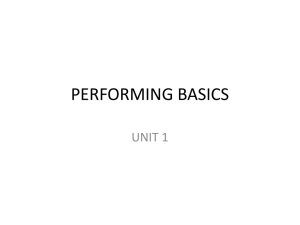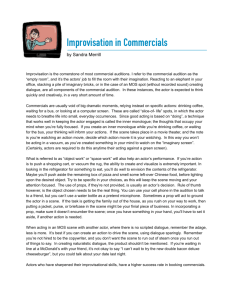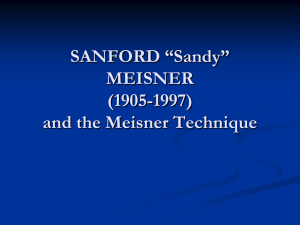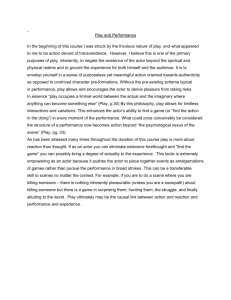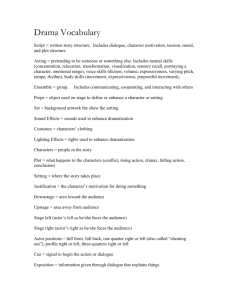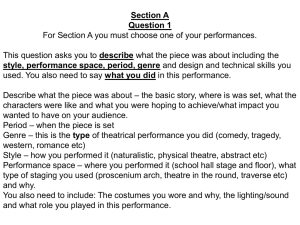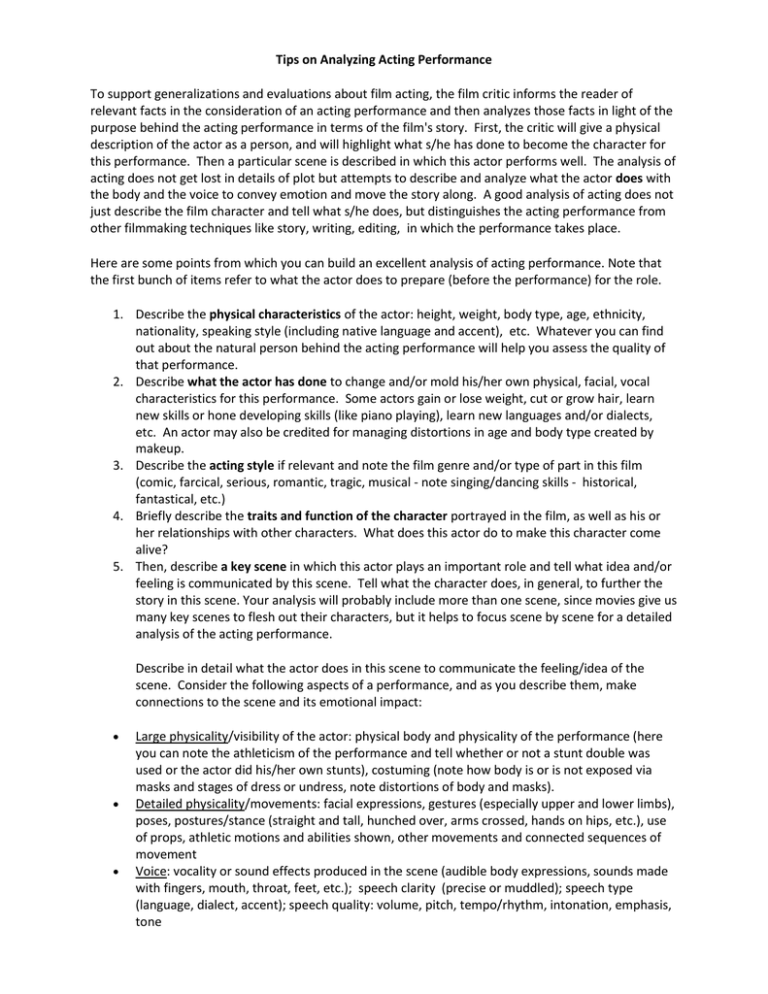
Tips on Analyzing Acting Performance
To support generalizations and evaluations about film acting, the film critic informs the reader of
relevant facts in the consideration of an acting performance and then analyzes those facts in light of the
purpose behind the acting performance in terms of the film's story. First, the critic will give a physical
description of the actor as a person, and will highlight what s/he has done to become the character for
this performance. Then a particular scene is described in which this actor performs well. The analysis of
acting does not get lost in details of plot but attempts to describe and analyze what the actor does with
the body and the voice to convey emotion and move the story along. A good analysis of acting does not
just describe the film character and tell what s/he does, but distinguishes the acting performance from
other filmmaking techniques like story, writing, editing, in which the performance takes place.
Here are some points from which you can build an excellent analysis of acting performance. Note that
the first bunch of items refer to what the actor does to prepare (before the performance) for the role.
1. Describe the physical characteristics of the actor: height, weight, body type, age, ethnicity,
nationality, speaking style (including native language and accent), etc. Whatever you can find
out about the natural person behind the acting performance will help you assess the quality of
that performance.
2. Describe what the actor has done to change and/or mold his/her own physical, facial, vocal
characteristics for this performance. Some actors gain or lose weight, cut or grow hair, learn
new skills or hone developing skills (like piano playing), learn new languages and/or dialects,
etc. An actor may also be credited for managing distortions in age and body type created by
makeup.
3. Describe the acting style if relevant and note the film genre and/or type of part in this film
(comic, farcical, serious, romantic, tragic, musical - note singing/dancing skills - historical,
fantastical, etc.)
4. Briefly describe the traits and function of the character portrayed in the film, as well as his or
her relationships with other characters. What does this actor do to make this character come
alive?
5. Then, describe a key scene in which this actor plays an important role and tell what idea and/or
feeling is communicated by this scene. Tell what the character does, in general, to further the
story in this scene. Your analysis will probably include more than one scene, since movies give us
many key scenes to flesh out their characters, but it helps to focus scene by scene for a detailed
analysis of the acting performance.
Describe in detail what the actor does in this scene to communicate the feeling/idea of the
scene. Consider the following aspects of a performance, and as you describe them, make
connections to the scene and its emotional impact:
Large physicality/visibility of the actor: physical body and physicality of the performance (here
you can note the athleticism of the performance and tell whether or not a stunt double was
used or the actor did his/her own stunts), costuming (note how body is or is not exposed via
masks and stages of dress or undress, note distortions of body and masks).
Detailed physicality/movements: facial expressions, gestures (especially upper and lower limbs),
poses, postures/stance (straight and tall, hunched over, arms crossed, hands on hips, etc.), use
of props, athletic motions and abilities shown, other movements and connected sequences of
movement
Voice: vocality or sound effects produced in the scene (audible body expressions, sounds made
with fingers, mouth, throat, feet, etc.); speech clarity (precise or muddled); speech type
(language, dialect, accent); speech quality: volume, pitch, tempo/rhythm, intonation, emphasis,
tone
Connections with other characters and objects, including space between characters and use of
props, reactions and other evidence of listening to, real interaction with, other actors in the
shot. How does the actor show his/her relationships with the other characters here?
Consider editing: whether the scene is one long take, or if the shots are long rather than short
cuts, in which case we are able to really see the actor at work. But if the scene is broken up into
many shots and short takes (more rather than less editing), then we can say that some, if not all,
of the acting performance is constructed by the editor so that the editor gets at least some of
the credit.
You say, "That's a lot of stuff!" And yes, a good actor brings a lot of stuff to her or his performance. Of
course, when you are discussing acting, don't feel you must touch on every point enumerated above.
Just think about these points as you come to assess the quality of an acting performance.
Here's an example of a piece out of a longer acting analysis of an imaginary mystery romance starring
Rita Hayworth and Clark Gable, movie stars in what have been called the "golden years" of Hollywood.
The film critic wants to say that Hayworth's acting is really good, and here picks a scene where Hayworth
communicates the flirtatiousness of her character, Karen. To say that the acting is "great" or that
Hayworth's performance "drips with sexuality and flirtatiousness" and end there is not very satisfying;
details to show what the actor does to communicate that she is flirting are needed to make for a
satisfying analysis of the acting performance. Here are a couple of ways to do this:
In the following example, Rita Hayworth's acting performance is described but the focus is on Karen, the
character in the story:
Karen (Rita Hayworth) is flirtatious in this scene. She shows she still desires John and oozes sexuality,
desire, and guile as she slinks toward him, swaying her hips and licking her lips. Her blue eyes glance at
him from under her eyebrows, and she keeps looking away as she approaches, then touches his arm,
presses her pelvis toward his thigh, smiles sensuously, and whispers, "I'm here" . . . . (And so on . . . this
is the way you start.)
To focus more on the actor herself, the film critic changes the emphasis and perspective, making the
actor's name primary (and putting the character name in parentheses):
In this scene, Rita Hayworth brilliantly portrays a flirtatious woman (as Karen) who still desires the man
(John, played by Clark Gable) she had brutally rejected. Hayworth exudes sexuality, desire, and guile by
slinking toward Gable, swaying her hips and licking her lips. Her blue eyes glance at him from under her
eyebrows, and she keeps looking away as she approaches, and then touches his arm, presses her pelvis
toward his thigh, smiles sensuously, and whispers, "I'm here."
When you provide details to show what the actor does to convey emotions and move scenes forward,
you not only enlighten your readers, but you give them a better appreciation of acting performance. The
details you give and the words you choose to describe the performance bring the scene back to life in
the mind of the reader. You are a generous film critic when you give enough detail so that the reader
can see and feel the film experience again, and in a new light. What a delight!
Revised 28 February 2009.
Modified from Gloria Floren, Letters Department, MiraCosta College, One Barnard Drive, Oceanside,
California 92056.
Contents Copyright 1998-2009 Gloria L. Floren. All rights reserved. U.S.A.

